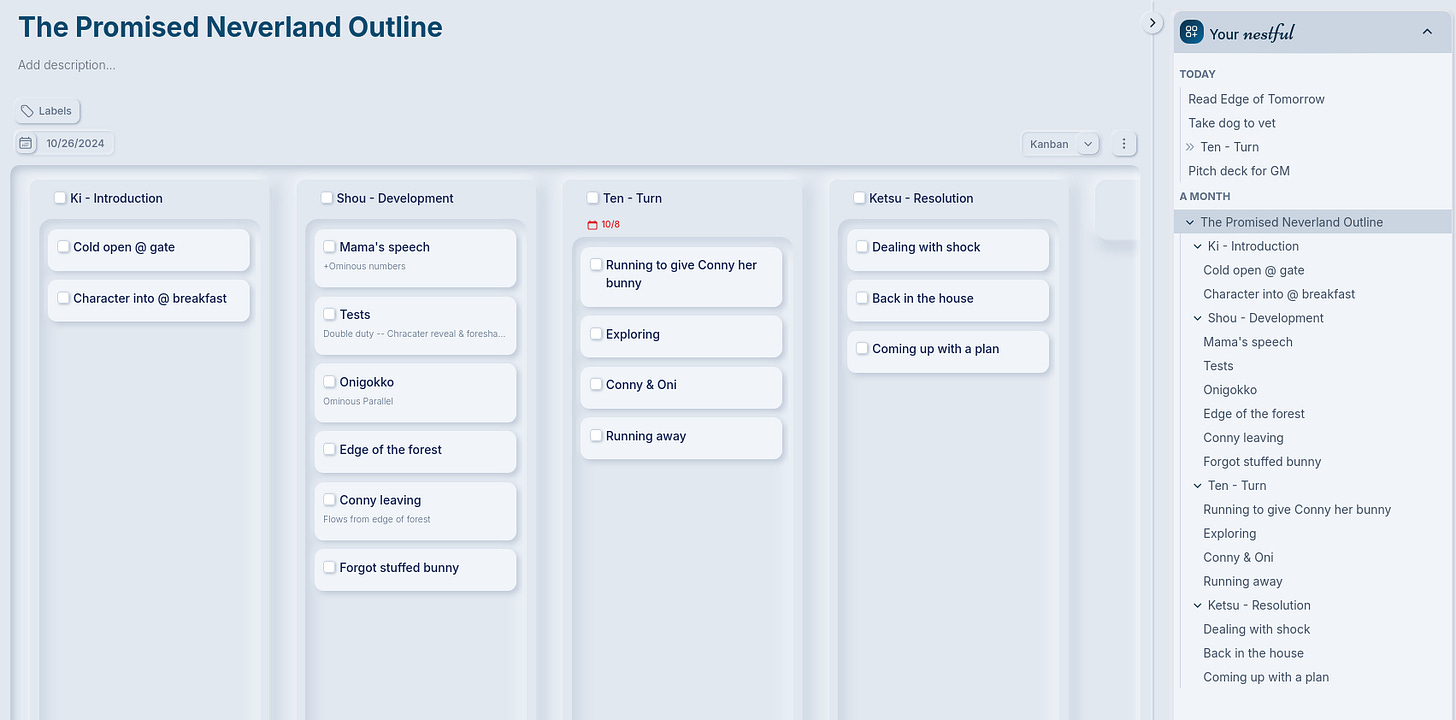Ways to use Nestful: Outlining Anime
What is "Kishoutenketsu" and how outlining using this popular Asian story structure is especially effective on Nestful
IMPORTANT: I use the pilot of The Promised Neverland as an example, so SPOILERS ahead. Do go watch it before reading this
Recently a software I make called Nestful had its desktop app released, and while I made it for a whole different reason, I use it a lot for outlining screenplays.
Nestful and Kishoutenketsu
Nestful was initially built to fill one purpose: be a task app that lets me compare tasks across different areas of my life. My daily job, my screenplays and my chores all compete for my time, yet are all siloed away, unable to be prioritized. Nestful solves this by nesting items in one another, allowing projects to be item of the same list, and inside have their own list to manage said project.
This turned out to be extremely useful for outlining, especially the Japanese-style structure of Kishoutenketsu, which is often used for Anime.
For those who are unfamiliar with Kishoutenketsu, it's a 4-act structure popular in Asia which originated in Japan, and is comprised of 4 acts. In Japanese they are called:
起 Ki - Introduction
承 Shou - Development
転 Ten - Turn (often translated as twist, but isn't necessarily a twist in the western sense)
結 Ketsu - Resolution
Kishoutenketsu is fairly flexible, with writers taking big liberties in the lengths of acts. The Promised Neverland employes a fairly common and clear division of 1/8, 1/2, 1/4, 1/8 for each of the acts respectively.
Outlining The Promised Neverland
I'll link below some videos about the structure if you want to learn more, but for now -- let's use The Promised Neverland's outline as an example:
First, in Ki, we are getting literally introduced -- to the characters, and to their environment. This is pure exposition, and is done by contrasting the unknown (numbers, gate) with the known (the children are happy),
This expands in Shou, where we're shown the abilities and faults of every major character as part of tests, and play. Note that almost every sequence serves more than one duty. The tests show not only who are the smartest characters, but also foreshadow the importance of their intelligence to the institution they're in. I've used the Japanese name for the game on tag, Onigokko, because its literal translation is "demon pretend", the one who's "it" pretends to be a demon. Shou then transitions brilliantly into Conny's leaving, where we have more character reveal and more environment contrast.
Ten starts with Conny's forgotten stuffed bunny. Emma and Norman run after her with it, reach the forbidden gate from the cold open, and cross it. They explore the very different environment, and find dead Conny. They then hide from what they soon find out are actual demons, and we get the twist -- their raised in a farm as food food. In this case the twist is truly a twist as we know it in the west, but it doesn't have to be -- in fact, it's not sufficient. What's needed is a turn in the story. In this case, the twist changed the perspective. But it can be, for example, a significant turn of events that changes goals without revealing information, as in some of Miyazaki's films.
Ketsu is very straightforward, showing the characters dealing with the shock, and planning for the future -- tying in what they went through in the episode.
Nesting Kishoutenketsu
So far you may think that although Kishoutenketsu may be interesting, outlining it is no different than any other index card outline, and all I have in that screenshot is a digital version of that.
You would be right, until we click on an item in that outline. Here’s how it looks when we click “Ten”:
Everything in Nestful is an Item, and items can be put inside of other items. This is useful to us because Kishoutenketsu is highly fractal. The structure is nested in itself, and the Ten act is the perfect example for that, with an item in the list for each of the sub-acts: Ki, Shou, Ten, Ketsu.
Now we can change Ten to be a board as well, rename the items, and outline the inner-acts in the exact same way. This is how it looks:
Flexibility and Beyond
This nesting method is flexible in two ways.
The first is its useful to other structures, or even no structure. Eventually a screenplay is big parts composed of smaller parts, which are themselves composed of yet smaller parts. This is independent of any structure, and you can mix and match different structures and layouts inside of others.
The second is that it only takes a list to do, so it can be done in a variety of tools. I find Nestful to be the most ergonomic one, but there are many other apps that have at least some nesting capability, even if not as central as Nestful's.
I hope this was useful to you! Before I add the Kishoutenketsu videos I promised, did you maybe notice this post itself has a certain structure? Maybe even this very paragraph?
Anyway, here they are:




